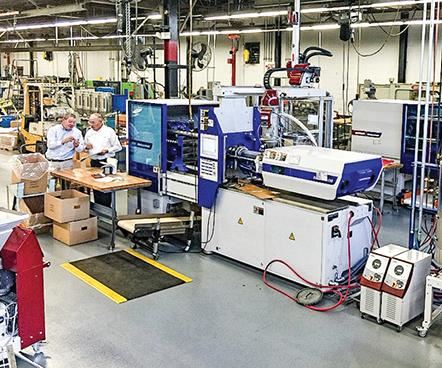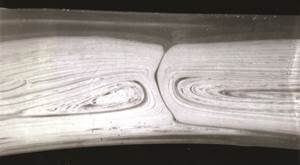High-Tech Molder Modernizes Its Fleet
EPC replaces older presses with its first all-electrics, in integrated cells from a single source.
When Matt McKenney came on board as general manager of Ensinger Precision Components (EPC) three years ago, a top priority was modernizing the plant’s fleet of injection machines. The 32-year injection molding veteran saw no alternative for a precision molder specializing in aerospace, defense, and medical applications using high-performance resins like PEEK, Ultem PEI, PPS, Torlon PAI, and Aurum TP polyimides, often with glass or carbon fibers. He says, “It’s important for us to modernize our equipment, not only for better performance, but to show customers we’re investing in our business.”
The latest phase in this program at EPC was the recent installation of three new molding cells based on EcoPower presses of 55, 110, and 180 metric tons from Wittmann Battenfeld, Inc., Torrington, Conn. They replaced three older machines, keeping the plant’s total at 20. The new additions dropped the average age of EPC’s machines (40 to 500 tons) from 18 years to 14, and McKenney’s goal is to bring that down to 10 years.
EPC in Putnam, Conn., is part of the $450-million Ensinger Group, based in Germany. EPC is one of five businesses of Ensinger North America. EPC is the descendant of a U.S. business that goes back 81 years and was one of the first companies to mold nylon in the 1940s, and also acted as the sole distributor of Battenfeld plunger machines in the 1950s. It was called Putnam Precision Molding when Ensinger acquired it in 1996.
The Putnam plant today occupies 66,000 ft2 and employs 66 people. Injection molding is 80% of its business, the rest being spin casting of PEEK tubes and plastic part machining. Besides custom parts production, 20% of its molding business is stock shapes.
“Buying these three new machines was a six-month project,” says McKenney. “We got the whole team involved. We examined eight machine suppliers and ultimately made a conscious decision to partner with Wittmann. It was a unanimous choice.”
One deciding factor was a single source for the presses and auxiliaries—including six temperature-control units, three dryers, six integral loaders, three granulators, and three servo robots. Notes McKenney, “What swayed the team most of all, beyond the quality of the product, was the ability to have all the equipment related to an injection molding cell manufactured by one company. This makes the line of communication very clear.”
Another key consideration, according to McKenney, was Wittmann’s “commitment to this region.” Located only 70 miles from EPC, “They have much bigger training facilities and staff than other vendors in the region.” The new work cells were fully assembled by Wittmann in Torrington and ran trials with EPC’s molds before being shipped to Putnam.
A third consideration was the user-friendliness of Wittmann Battenfeld’s controls. “Our people find them more intuitive than other brands,” McKenney says.
As for performance, McKenney reports that “a customer saw a test run from the new Battenfeld 110 and said he had never seen such repeatability over 50 parts. It was a PEEK part with dimensional tolerances of +0.5/-1 mil.” EPC is planning another purchase this year of a Wittmann Battenfeld vertical press for molding thick stock shapes. “They require very consistent packing with a weight variation less than 0.3% on parts up to 10 oz.”
The new presses are EPC’s first all-electric models. “We won’t buy any more conventional hydraulic presses,” says McKenney. “Power is very expensive here.”
Related Content
How to Get Rid of Bubbles in Injection Molding
First find out if they are the result of trapped gas or a vacuum void. Then follow these steps to get rid of them.
Read MoreImprove The Cooling Performance Of Your Molds
Need to figure out your mold-cooling energy requirements for the various polymers you run? What about sizing cooling circuits so they provide adequate cooling capacity? Learn the tricks of the trade here.
Read MoreWhat to Do About Weak Weld Lines
Weld or knit lines are perhaps the most common and difficult injection molding defect to eliminate.
Read MoreHow to Set Barrel Zone Temps in Injection Molding
Start by picking a target melt temperature, and double-check data sheets for the resin supplier’s recommendations. Now for the rest...
Read MoreRead Next
People 4.0 – How to Get Buy-In from Your Staff for Industry 4.0 Systems
Implementing a production monitoring system as the foundation of a ‘smart factory’ is about integrating people with new technology as much as it is about integrating machines and computers. Here are tips from a company that has gone through the process.
Read MoreAdvanced Recycling: Beyond Pyrolysis
Consumer-product brand owners increasingly see advanced chemical recycling as a necessary complement to mechanical recycling if they are to meet ambitious goals for a circular economy in the next decade. Dozens of technology providers are developing new technologies to overcome the limitations of existing pyrolysis methods and to commercialize various alternative approaches to chemical recycling of plastics.
Read MoreProcessor Turns to AI to Help Keep Machines Humming
At captive processor McConkey, a new generation of artificial intelligence models, highlighted by ChatGPT, is helping it wade through the shortage of skilled labor and keep its production lines churning out good parts.
Read More




























.png;maxWidth=970;quality=90)